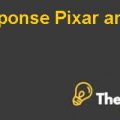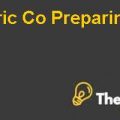
Problem: 1
Net Working Capital: Net working capital is a quick measurement of a business’ liquidity position. It indicates whether the company has sufficient current assets to set-off its current liabilities. The company in Problem 1 has positive net working capital of $1,519, so it means that the company has sufficient current-assets to set off its current liabilities.
Cash Conversion Cycle:
CCC measures how long a company would take to sell its inventory, collect receivables and pay debt. The company has inventory turnover period of 2.6 days, receivables turnover period of 17.94 days and average payable period of 22.91 hence, the company has a negative cash conversion cycle of -2.38 days. This means that the company does not have to pay for any inventory until it sells the final product and it also indicates that the firm has cash available for other activities as well.
Problem: 2
- Bob wishes to double his business, so initially he will require a capital of $180,000 in its first month of operation. However, this capital requirement will gradually decrease as long as Bob receives his project instalments.
Exhibit-1 clearly shows that capital requirements gradually decrease over periods because operating profits are being continuously utilized to pay-off its debts. At the end of tenth month, Bob will not be having any outstanding dues.
- There are many ways at Bob’s disposal to achieve this growth.
a.) In our analysis in Exhibit-2, we are assuming that Bob receives loan of $90,000. This amount is half of the capital, which is required by Bob so he shall not start both the projects at the same time. The second project shall be started after the end of first month, so that the Bob receives payment every month on a continuous basis and the outstanding dues of sub-contractors of one project can be set-off against payments of the second project. Adopting this approach would enable Bob to repay his outstanding loan at the end of sixth month.
b.) Bob can also discuss with his clients to revise the terms of payment. Bob may request his clients to pay him in advance for his projects. It is quite justifiable that clients may agree on the revised terms because Bob has already an excellent reputation in the market and his work has been highly appreciated. If Bob succeeds to convince his clients to revise the terms of payment then Bob can start both the projects simultaneously.
Problem: 3
The NPV of the project is positive ($63,333), so the project is financially viable but before accepting the new project, Natasha shall focus on working capital requirements as well because the nature of the business requires her to hold heavy inventory in stores. Thus funds might get stuck, which increases the need for working capital.
Foreign exchange currency risk is also a major concern for Natasha because she usually imports her ingredients from other countries; depreciation of local currency may threaten the long term cash flows of the proposed project.
Another major concern for Natasha is that ingredients are itself perishable in nature, furthermore it requires a long lead time to import these and the business requires heavy inventory storage which might cause inventory level to write off.
Problem 4:
I absolutely agree with owners. The proposed investors bid on the basis of growing perpetuity but valuation of the company may sometimes be very complex; different valuation models are adopted to determine the actual worth of the company. Valuation analysis strongly focuses on the fair value of assets, liabilities and balance sheet items as well. Once the actual worth of assets and liabilities are determined, the proposed investors may pay excess then their net equity for the company’s goodwill...............................
This is just a sample partial case solution. Please place the order on the website to order your own originally done case solution.












